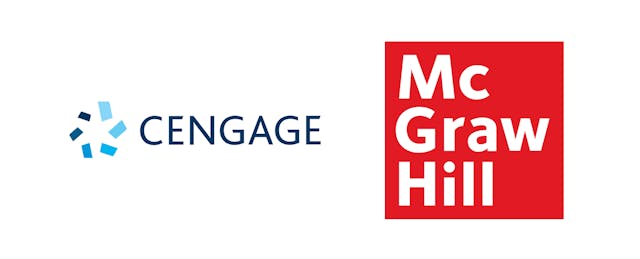Cengage and McGraw-Hill Education plan to join forces in an all-stock merger. The news, first reported by The Wall Street Journal, would create the second-biggest U.S. textbook publisher if the deal is approved, with a combined valuation estimated at $5 billion. Pearson, with a market cap of $8.5 billion, would still be ahead of the pack.
The new company will retain the McGraw Hill name (but without the hyphen), and will be led by Michael Hansen, currently the CEO of Cengage. Dr. Nana Banerjee, who holds that title for McGraw-Hill Education, is expected to depart. Prior to his ascension last April, McGraw-Hill had cycled through a couple of other chief executives earlier this decade, including Lloyd G. “Buzz” Waterhouse and David Levin.
Like other established textbook publishers, both companies have reoriented their businesses around digital offerings. That transition has not always been smooth. Cengage filed for bankruptcy in 2013, after which it reached an agreement to eliminate $4 billion in debt and secure $1.75 billion in exit financing.
What does this textbook publisher mega-merger mean for professors and students? Read our follow-up story: How Merger of Two Textbook Giants Could Impact Course Materials
Cengage is now betting its digital business on an annual subscription that gives students unlimited access to all of its digital textbook materials, along with online homework tools and study guides. Earlier this February, it claimed to have sold 1 million such subscriptions since the program was launched in August 2018.
On a conference call about the planned merger, Cengage’s Hansen said the idea behind this digital subscription, called Cengage Unlimited, is to make the secondary resale market for print textbooks less appealing for students. “Why would you go to the aftermarket when there is a compelling choice of options in front of you?”
Last week, Cengage reported $1.5 billion in revenue for its fiscal year ending in March 2019.
McGraw-Hill Education is currently owned by Apollo Global Management, a private equity firm that bought the company for $2.4 billion in 2013. From that year through 2017, the company invested an estimated $700 million to bolster its education technology offerings, according to The Telegraph. Its acquisitions include Redbird Advanced Learning (a K-12 math, reading and writing curriculum provider) Area9 (an adaptive learning technology) and ALEKS (an online adaptive math program).
McGraw-Hill Education filed for an IPO in 2015 but withdrew three years later. It reported $1.6 billion in revenue in 2018, of which 42 percent came from its higher-ed business, and 35 percent from the K-12 side. (The rest is made up of international and professional markets.) Sales of digital offerings made up 63 percent and 35 percent of its higher-ed and K-12 business, respectively.
Combined, the two companies generated an estimated $3.1 billion in revenue in 2018, and will boast a library of 44,000 textbook titles, according to the Journal. Hansen told the newspaper that the merger will save an estimated $300 million over the next three years—savings that he claims will be passed down to make college materials more affordable. On the conference call, he added that the savings will come from reduced labor costs and further consolidation of the publishers’ physical and digital infrastructure and operations.
Cengage had already downsized earlier this year, closing its San Francisco office and cutting staff in other regions. These moves were foreshadowed during its most recent investor earnings call earlier this February, when Hansen said the company is “now on the move to simplify and streamline our operations and cost structure.”
On the conference call about the merger, one analyst asked whether the new company will get into the online program management (OPM) business to help universities operate online programs, something that its competitors that Pearson and Wiley have dabbled in. Hansen replied, rather definitively: “We are not in the business of recruiting students to schools. That is not a business we should get in.”
Banerjee told the Journal that taking the combined company public is a possibility.


